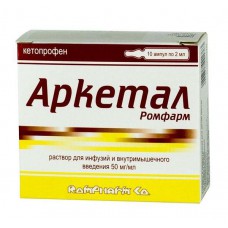Expiration date: 10/2026
Composition
1 ml of solution for I/o and I/m introduction contains:
Active substance
Ketoprofen 50 mg.
Auxiliary substance
Ethanol 96% - 100 mg, propylene glycol-400 mg, benzyl alcohol-20 mg, sodium hydroxide-8.5 mg, 10% sodium hydroxide solution or hydrochloric acid-up to pH 7.2±0.2, water d / I-up to 1 ml.
In an ampoule 2 ml of solution. In a contour acheikova package 5 ampoules. In a cardboard bundle 2 contour packages.
Indications for use
Symptomatic therapy of inflammatory and degenerative diseases of the musculoskeletal system:
- Rheumatoid arthritis.
- Psoriatic arthritis.
- Bekhterev's disease (ankylosing spondylitis).
- Gouty arthritis.
- Osteoarthrosis.
- Designed for symptomatic therapy, reduce pain and inflammation at the time of use, the progression of the disease does not affect.
Pain syndrome:
- Myalgia.
- Ossalgia.
- Neuralgia.
- Tendonitis.
- Bursitis.
- Arthralgia.
- Radiculitis.
- Adnexitis.
- Otitis.
- Headache.
- Toothache.
- Pain syndrome in cancer.
- Post-traumatic and postoperative pain syndrome accompanied by inflammation.
- Algodismenorrhea.
- Childbirth (as analgesic and tocolytic drugs).
Pharmacokinetics
Suction
Absorption-fast. T max in plasma - 15-30 min. Bioavailability is more than 90%.
Distribution
Binding to plasma proteins-99%. Therapeutic concentration in synovial fluid is maintained for 6-8 hours.
A significant amount does not penetrate the blood-Brain barrier .
Metabolism
Almost completely metabolized in the liver by glucuronidation. Is subjected to the effect of "first pass" through the liver.
Breeding
It is excreted by the kidneys-60-80% in the form of glucuronide for 24 hours.
Pharmacokinetics in special clinical cases
In patients with renal insufficiency Ketoprofen is excreted more slowly, the T 1/2 increased to 1 h.
In patients with hepatic insufficiency Ketoprofen can accumulate in tissues.
In elderly patients, metabolism and excretion of Ketoprofen is slower, but it has clinical significance only for patients with reduced renal function.
Clinical pharmacology
NSAIDs, a derivative of propionic acid.
It has analgesic, anti-inflammatory and antipyretic effects. By inhibiting COX-1 and COX-2 and, partially, lipoxygenase, Ketoprofen inhibits the synthesis of prostaglandins and bradykinin, stabilizes the lysosomal memrane.
Ketoprofen has no negative effect on the condition of articular cartilage.
Application during pregnancy and breast-feeding
Arketal Rompharm is contraindicated for use in the III trimester of pregnancy. In I and II trimesters of pregnancy the use of Acetal Rompharm is possible in cases when the potential benefit to the mother outweighs the potential risk to the fetus, to be used only under the supervision of a physician.
If necessary, use Acetal Rompharm lactation breastfeeding should stop.
Contraindications
- Full or partial combination of bronchial asthma, recurrent polyposis of the nose and paranasal sinuses and nepredosuditelnaya acid or other NSAIDs, including history.
- Peptic ulcer of the stomach and duodenum in the phase of exacerbation.
- Ulcerative colitis in the acute phase.
- Crohn disease.
- Diverticulitis.
- Peptic ulcer.
- Hemophilia and other blood clotting disorders.
- Active gastrointestinal bleeding.
- Severe hepatic impairment or active liver disease.
- Expressed renal failure (CC less than 30 ml/min).
- The progression of kidney disease.
- Uncompensated heart failure .
- The postoperative period after coronary artery bypass grafting.
- Confirmed hyperkalemia.
- Inflammatory bowel disease.
- Pregnancy.
- Lactation (breastfeeding).
- Children under 15 years of age.
- Hypersensitivity to the components of the drug.
With caution:
- Anemia
- Bronchial asthma.
- Alcoholism.
- Smoking.
- Alcoholic cirrhosis.
- Hyperbilirubinemia.
- Liver failure.
- Dehydration.
- Sepsis.
- Chronic heart failure.
- Edemas.
- Arterial hypertension.
- Blood diseases, including:
- Leukopenia.
- Stomatitis.
- Coronary heart disease
- Cerebrovascular disease.
- Dyslipidemia / hyperlipidemia.
- Diabetes.
- Peripheral arterial disease.
- Chronic renal insufficiency (QC 30-60 ml/min).
- Ulcerative lesions of the gastrointestinal tract in history.
- Presence of Helicobacter pylori infection.
- Long-term use of NSAIDs.
- Severe somatic diseases.
Simultaneous application:
Oral corticosteroids:
- Prednisolone's.)
Anticoagulants, including:
- Warfarin.)
Antiplatelet agents, including:
- Clopidogrel.
Selective serotonin reuptake inhibitors, incl. :
- Of citalopram .
- Fluoxetine's.
- Paroxetine's.
- Sertraline's.
- Old age.
Side effect
From the digestive system
NSAID-gastropathy, stomach pain, dyspepsia (nausea, vomiting , heartburn, flatulence, loss of appetite, diarrhea), stomatitis, abnormal liver function, a change of taste.
From the Central and peripheral nervous system
Headache, Dizziness, Insomnia, excitement, nervousness, drowsiness, Depression , confusion or loss of consciousness, migraine , peripheral neuropathy.
From the sensory organs
Noise or ringing in the ears, blurred visual perception, conjunctivitis, dryness of the eye mucosa, pain in the eyes, conjunctiva hyperemia, hearing loss, Vertigo.
From the cardiovascular system
Increased blood pressure, tachycardia .
From the hematopoietic system
Agranulocytosis, Anemia, hemolytic anemia, thrombocytopenia, leukopenia.
From the urinary system
Edema syndrome, cystitis, urethritis, impaired renal function, interstitial nephritis, nephrotic syndrome, hematuria.
Allergic reaction
Skin rash (including erythematous), urticaria, itching of the skin, rhinitis, angioedema, bronchospasm, exfoliative dermatitis, anaphylactic shock.
Local reaction
Burning or pain at the injection site.
Other
Increased sweating, hemoptysis, nasal bleeding, Myalgia, muscle twitching, shortness of breath, thirst, photosensitization.
Long-term use in high doses
Vaginal bleeding.
Interaction
Farmatsevticeski incompatible with the solution of tramadol .
Reduces the effectiveness of uricosuric drugs.
Do the anti, antiagregantov, fibrinolitikov, ethanol , side effects of gluco - and mineralocorticoids, estrogens.
Reduces the effectiveness of antihypertensive drugs and diuretics.
Concomitant use with other NSAIDs, GKS, ethanol, corticotropin may lead to ulceration and development of gastrointestinal bleeding, the increased risk of impaired renal function.
Concomitant use with indirect anticoagulants, heparin with thrombolytic drugs, antiplatelet agents, cefoperazone, cefamandole and cefotetan increases the risk of bleeding.
Increases hypoglycemic effect of insulin and oral hypoglycemic drugs (requires the recalculation of doses).
Inductors of microsomal liver enzymes (phenytoin , ethanol, barbiturates, rifampicin, phenylbutazone, tricyclic antidepressants) increase the production of hydroxylated active metabolites.
Joint appointment with valproic acid causes a violation of platelet aggregation.
Increases concentration in plasma of verapamil and nifedipine, drugs lithium , methotrexate.
Mielotoksicnae drugs increase the manifestation gematotoksichnosti drug.
Overdose
The overdose was identified at doses of more than 2.5 g of Ketoprofen.
Symptoms: increased dose-dependent side effects-convulsions, a feeling of heaviness in the legs, increased blood PRESSURE, ringing in the ears, blurred visual perception, rash, nausea, vomiting , diarrhea, gastrointestinal bleeding, headache, Dizziness, incoherent (incoordination), confusion, drowsiness, convulsions, coma, respiratory depression.
Treatment: gastric lavage, the appointment of activated charcoal, symptomatic therapy. The specific antidote is unknown. Conduct appropriate hydration, observe renal clearance and correct acidosis. If necessary, apply hemofiltration.
Method of application and doses
Adults the drug is injected in/in drip or/m.
In / m - 100 mg 1-2 times / day.
In/in the drip - 100-200 mg in 100-500 ml of 0 9% sodium chloride solution. Infusions are carried out only in hospital, no more than 300 mg for 0, 5-1 hours.
The maximum daily dose is 300 mg.
Treatment with the drug is carried out briefly (2 -3 days). If necessary, treatment is continued with other dosage forms.
Rules of administration
/M
V/m the drug is injected deeply, slowly, in the upper outer square of buttocks, under strictly aseptic conditions.
A subsequent injection is injected alternately in each buttock.
In/in
Short-term infusion-from 100 to 200 mg Ketoprofen diluted in 100 ml of 0, 9% sodium chloride solution and injected for 0, 5-1 hours, the introduction can be repeated every 8 hours, for no more than 48 hours.
Long-term infusion-from 100 to 200 mg Ketoprofen diluted in 500 ml infusion solution (0, 9% sodium chloride solution, lactate ringer solution, dextrose solution) and administered for 8 hours, the introduction can be repeated every 8 hours, for no more than 24 hours.
Due to the fact that Ketoprofen is sensitive to light, a vial or infusion bag should be covered with black paper or aluminum foil.
Use in special clinical cases
In elderly patients, the drug is recommended to be used in a minimum effective dose. Patients require regular surveillance, because maybe gastrointestinal bleeding during NSAID therapy.
In patients with renal insufficiency, the drug is recommended to be used in a minimum effective dose, which is then corrected depending on the state of kidney function.
Precautionary measures
During treatment, it is necessary to control the picture of peripheral blood and the functional state of the kidneys and liver.
If it is necessary to determine 17-ketosteroids, the drug should be canceled 48 hours before the study.
The use of Ketoprofen can mask the signs of infectious disease.
To reduce the risk of adverse events on the part of the gastrointestinal tract should use a minimum effective dose of a minimum short course.
Due to the fact that Ketoprofen is sensitive to light, a vial or infusion bag should be covered with black paper or aluminum foil.
Application in violation of kidney function
Contraindicated in severe violations of kidney function.
In violation of kidney function, dose reduction and careful monitoring are necessary.
Application in violation of liver function
Contraindicated in severe violations of liver function.
In violation of liver function, dose reduction and careful monitoring are necessary.
Use in paideh
In elderly patients, the drug is recommended to be used in a minimum effective dose. Patients require regular surveillance, because maybe gastrointestinal bleeding during NSAID therapy.
Use in children
Contraindications: children under 15 years of age.
Influence on the ability to drive vehicles and control mechanisms
During the period of treatment must be careful when driving and occupation of other potentially hazardous activities, require high concentration and psychomotor speed reactions.
Storage conditions
Store in a dark place at a temperature not exceeding 25°C.
Shelf life: 3 years.
Keep out of reach of children.
Do not use after the expiry date.


